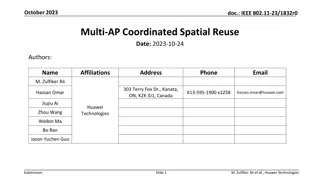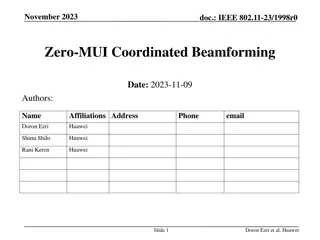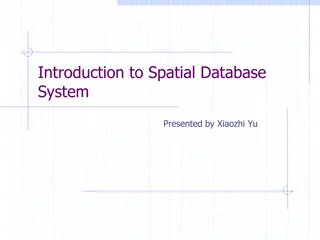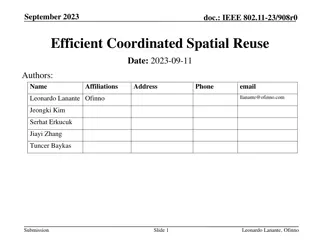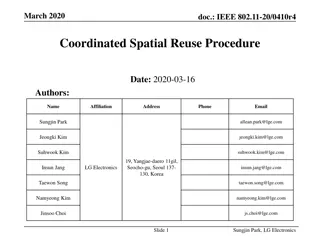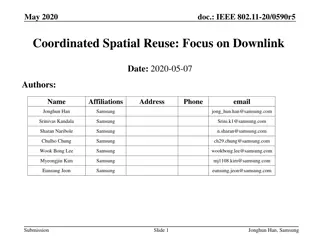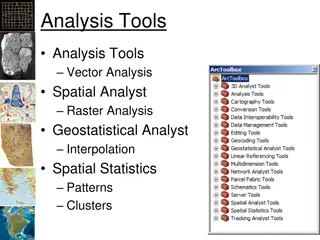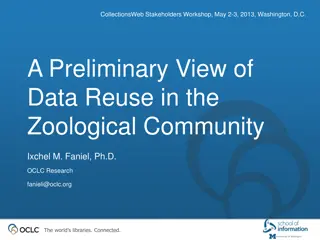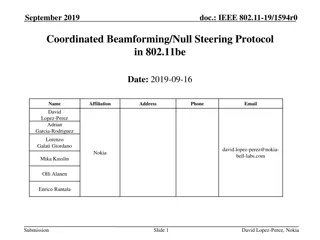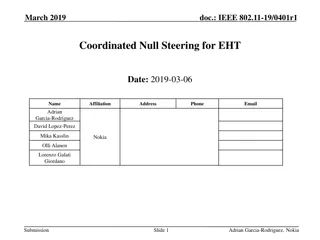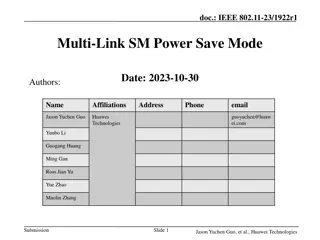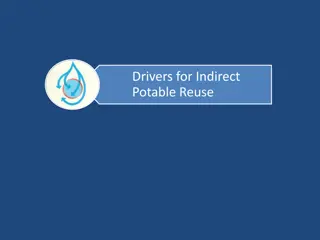Analysis of Power Control for Coordinated Spatial Reuse in IEEE 802.11-24
Evaluation of power control schemes for Coordinated Spatial Reuse (CSR) in IEEE 802.11-24, comparing benefits with and without power control. Results show gains in throughput and SINR with different CSR schemes and considerations for shared access points. Concerns and insights shared on the effectiveness of power control in CSR scenarios.
Download Presentation

Please find below an Image/Link to download the presentation.
The content on the website is provided AS IS for your information and personal use only. It may not be sold, licensed, or shared on other websites without obtaining consent from the author.If you encounter any issues during the download, it is possible that the publisher has removed the file from their server.
You are allowed to download the files provided on this website for personal or commercial use, subject to the condition that they are used lawfully. All files are the property of their respective owners.
The content on the website is provided AS IS for your information and personal use only. It may not be sold, licensed, or shared on other websites without obtaining consent from the author.
E N D
Presentation Transcript
January 2024 doc.: IEEE 802.11-24/0114r1 Thoughts on Power Control for CSR Date: 2024-01-12 Authors: Name Wook Bong Lee Affiliations Apple Address Phone email wookbong.lee@apple.com Anuj Batra Submission Slide 1 Wook Bong Lee, Apple
January 2024 doc.: IEEE 802.11-24/0114r1 Introduction Coordinated Spatial Reuse (CSR) is a technology being considered for UHR In [1-2], authors show gains of CSR In [3], authors show gains of CSR and CBF In [4], authors proposed a sharing AP to control the transmit power of shared APs In [5], authors proposed a non-AP STA to measure neighboring APs signal level (e.g. RSSI) In this contribution, we compared two different schemes, with and without transmit power control, and shared our concern on transmit power control for CSR Submission Slide 2 Wook Bong Lee, Apple
December 2023 doc.: IEEE 802.11-24/0114r1 Results From Other Contributions (1/3) In [1], a CSR scheme with fairness constraint is evaluated The Sharing AP will limit the amount of SINR reduction allowed 3-30% gain is observed for scenario in right above figure 23-53% gain is observed for scenario in right below figure Midpoint SNR % CSR Gain vs TDMA 1K QAM 28.5 4K QAM 28.5 22.5 20% 20% 30% 20% 26% 22% 33.5 22.5 17% 17% 28% 33.5 20M 1x1-1ss AWGN 80M 1x1-1ss AWGN 20M 1x1-1ss B-LOS 80M 1x1-1ss B-LOS 20M 1x1-1ss D-NLOS 20M 2x2-2ss B-LOS 8% 11% 18% 11% 13% 11% 8% 8% 13% 8% 11% 9% 6% 8% 15% 3% 4% 8% R=3/4*D 20% 8% 5% 80M 2x2-2ss B-LOS 20% 11% 7% 20M 1x1-1ss AWGN 20M 1x1-1ss D-NLOS 53% 53% 44% 44% 51% 51% 43% 24% 23% R=3/8*D 20M 2x2-2ss B-LOS Midpoint SNR 22.5 dB -82 dBm RSSI @ far AP Midpoint SNR 42.5 dB -62 dBm RSSI @ far AP 43% 36% 39% 34% 23% 20% Submission Slide 3 Wook Bong Lee, Apple
December 2023 doc.: IEEE 802.11-24/0114r1 Results From Other Contributions (2/3) In [2], a CSR scheme with fairness constraint (CSR-MCSmax) is evaluated The shared AP can t reduce throughput of the sharing AP 5-29% gain is observed for scenario in right above figure 75-90% gain is observed for scenario in right below figure PD ED Submission Slide 4 Wook Bong Lee, Apple
December 2023 doc.: IEEE 802.11-24/0114r1 Results From Other Contributions (3/3) In [3], CSR and CBF scheme with full power transmission at sharing AP and shared AP is evaluated 18-91% gain (depending on STA s SNR and interference level) is observed in two AP with one STA per AP 16-98% gain (depending on STA s SNR and interference level) is observed in two AP with two STA per AP Detail results is captured in appendix 42-262% gain (depending on STA s SNR and interference level) is observed in four AP with one STA per AP Detail results is captured in appendix Two AP, one STA per AP Serving AP STASNR (dB) 35 30 25 20 15 10 1.17, 1.19 1.13, 0.09 1.18, 1.34 1.14, 0.27 1.19, 1.41 1.15, 0.47 1.19, 1.47 1.15, 0.82 1.19, 1.58 1.17, 1.24 1.19, 1.72 1.18, 1.46 1.19, 1.85 1.19, 1.76 1.18, 1.12 1.10, 0.10 1.21, 1.26 1.11, 0.30 1.23, 1.36 1.13, 0.53 1.24, 1.47 1.14, 0.90 1.24, 1.55 1.16, 1.33 1.25, 1.63 1.21, 1.57 1.29, 1.76 1.27, 1.73 1.33, 0.99 1.19, 0.11 1.33, 1.10 1.20, 0.38 1.35, 1.25 1.22, 0.64 1.35, 1.48 1.26, 1.02 1.35, 1.66 1.31, 1.52 1.35, 1.86 1.35, 1.83 1.35, 0.85 1.25, 0.13 1.35, 0.95 1.27, 0.47 1.35, 1.10 1.30, 0.78 1.35, 1.32 1.34, 1.12 1.39, 1.58 1.38, 1.53 1.47, 1.82 1.46, 1.81 1.80, 0.79 1.45, 0.13 1.80, 0.99 1.53, 0.59 1.81, 1.20 1.68, 1.02 1.86, 1.41 1.82, 1.36 1.91, 1.54 1.91, 1.53 1.63, 0.42 1.33, 0.03 1.68, 0.72 1.50, 0.46 1.84, 1.01 1.73, 0.96 1.98, 1.26 1.96, 1.24 0 5 10 X 15 (dB) 20 25 30 X is pathloss difference between serving AP and neighboring AP Rows with white color is for the gain of CSR over TDMA. Purple color is for the gain of CBF over TDMA. Submission Slide 5 Wook Bong Lee, Apple
December 2023 doc.: IEEE 802.11-24/0114r1 Evaluated Scheme: A Scheme with Power Control CSR scheme with fairness constraint [1] Sharing AP will always transmit during its TXOP, and the sharing AP will limit the amount of SINR reduction allowed Sharing AP: TXOP holder Shared AP: AP which is allowed to transmit during the TXOP by the sharing AP Victim STA(s): selected STA(s) for the sharing AP Submission Slide 6 Wook Bong Lee, Apple
December 2023 doc.: IEEE 802.11-24/0114r1 A Scheme with Power Control: High-level Concept for Simulation An AP grabs a medium and selects a STA The AP becomes a sharing AP, the STA become a victim STA If the selected STA has a MU-MIMO pair, then the MU-MIMO pair STA becomes a victim STA as well The sharing AP sets each shared AP s signal power to be not greater than the noise level at the victim STAs This is done based on periodic OBSS RSSI measurement by non-AP STAs This results in maximum 8.5 dB SINR degradation (including 3 dB RSSI measurement error and maximum 3 shared APs) at the victim STA(s) Submission Slide 7 Wook Bong Lee, Apple
December 2023 doc.: IEEE 802.11-24/0114r1 Evaluated Scheme: A Scheme without Power Control CSR for center STAs and CBF for other STAs A center STA is an STA with high RSSI for the serving AP Sharing AP and shared APs use its maximum transmit power Submission Slide 8 Wook Bong Lee, Apple
December 2023 doc.: IEEE 802.11-24/0114r1 A Scheme without Power Control: High-level Concept for Simulation An AP grabs a medium and selects a STA The AP becomes a sharing AP, the STA become a victim STA If the selected STA has a MU-MIMO pair, then the MU-MIMO pair STA becomes a victim STA as well If the victim STA(s) are center STA(s), then The shared APs select its center STA(s) for transmission If there is no center STA in a shared AP, then there is no transmission by the shared AP If the center STA has a MU-MIMO pair (another center STA), then the shared AP performs MU-MIMO If the victim STA(s) are not center STA(s), then The sharing AP performs CBF with a shared AP that has the CBF pair of the selected STA(s) For CBF, we have evaluated two cases CBF (local CSI) is that a non-AP STA feed backs MU Exclusive Beamforming Report (V matrix and delta SNR) for its own AP and the paired AP CBF (full CSI) is that a non-AP STA feed backs MU Exclusive Beamforming Report as well as U matrix for its own AP and the paired AP Submission Slide 9 Wook Bong Lee, Apple
December 2023 doc.: IEEE 802.11-24/0114r1 Simulation Scenarios Frequency Reuse 4 (20 MHz): Frequency Reuse 1 (80 MHz): All BSSs are using the same channel STAs are within BSS radios (R=0.75D) and associated with the closest BSS APs use four different channels. The illustration depicts APs with the same channel. Simulation is done only with APs with the same channel. STAs are within BSS radios (R=0.375D) and associated with the closest BSS Wook Bong Lee, Apple Submission Slide 10
December 2023 doc.: IEEE 802.11-24/0114r1 Common Simulation Assumptions (1/3) PHY level simulation Downlink full buffer traffic All PPDUs are aligned All BSSs can hear each other There is no collision There is no SIG error There is no MAC overhead Number of antennas: AP (Ntx) = 4, non-AP STA (Nrx) = 2, Maximum Nss = 2 for each non-AP STA with maximum MCS = 11 5 GHz and channel B (both for fading channel and path loss) Ideal beamforming (SU/MU/CBF depending on scheme and scheduler decision) is assumed All evaluated BSSs have the same bandwidth on the same channel Submission Slide 11 Wook Bong Lee, Apple
December 2023 doc.: IEEE 802.11-24/0114r1 Common Simulation Assumptions (2/3) AP to AP distance: 27.3 meters (D=27.3) AP s maximum power: from 10 to 30 dBm 10 dBm: PD at far AP, i.e. RSSI of -82 dBm at the diagonal AP 30 dBm: ED at far AP, i.e. RSSI of -62 dBm at the diagonal AP 100 drops, and each drop contains 200 packets of initialization to settle link adaptation and feedback 500 packets of data transmission: 5 ms PPDU length, all PPDUs are aligned Time-varying channel It is generated by an interpolation of two independent channels at every 800 ms There are about -40dB changes in frequency domain every 5 ms This is no channel variation within a PPDU Baseline (legacy) A single AP transmits to a single STA (SU-MIMO) or two STAs (MU-MIMO) Submission Slide 12 Wook Bong Lee, Apple
December 2023 doc.: IEEE 802.11-24/0114r1 Common Simulation Assumptions (3/3) Link adaptation/Fast feedback APs select MCS and NSS (best among [2 2]/[2 1]/[1 2]/[1 1]/[2 0]/[0 2]/[1 0]/[0 1] streams) based on long term SNR + SINR adjustment (initially set to a certain value based on the mode of operation) A non-AP STA feeds back effective SINR of the received PPDU AP updates SINR adjustment (= Effective SINR (feedback by a non-AP STA) - SINR used by AP when selecting MCS and Nss of the PPDU) Note that for different PHY parameters (e.g. CSR/CBF/MU-MIMO, Nss, Nss,tot, etc), AP needs to maintain different SINR adjustments: AP maintains feedback information for each PHY parameter For MU-MIMO, pairs are maintained within a drop unless the link adaptation chooses to fall back to SU If the estimated SINR is below the required SINR for MCS0, Nss1, AP will not transmit to the STA except for the victim STA(s) If victim STA(s) can t be served, then remove one of the shared AP (the closest AP to the sharing AP first, randomly between two closest APs) Submission Slide 13 Wook Bong Lee, Apple
December 2023 doc.: IEEE 802.11-24/0114r1 Simulation Results: Reuse 1, 4 STAs per AP A scheme without power control performs much better than a scheme with power control As observed in others contributions, CSR with power control provides less gain as the transmit power of AP increases This is due to the interference level from the sharing AP to shared APs increases while the shared AP s transmit power is determined by path loss of the shared AP and victim STA(s) which is fixed regardless of the maximum transmit power of the AP (or sharing AP s transmit power) A CSR with power control was proposed for fairness If an AP selects victim STAs properly and another AP shares its TXOP as well, then there seems no fairness issue as shown in per STA throughput in the next slide AP-AP distance: 27.3 m, Channel B, MU-MIMO, Feedback 160 CSR w/ power control CSR wo/ power control CBF(local CSI) CSR wo/ power control+CBF(local CSI) CBF(full CSI) CSR wo/ power control+CBF(full CSI) 150 Percentage compared to legacy throughput 140 130 120 110 100 90 80 10 12 14 16 18 20 22 24 26 28 30 APs max Tx Power [dBm] 4 STAs per AP Submission Slide 14 Wook Bong Lee, Apple
March 2023 doc.: IEEE 802.11-24/0114r1 Per STA Throughput: Reuse 1, 4 STAs per AP Max Tx Pwr = 20 dBm Max Tx Pwr = 10 dBm 1 1 0.9 0.9 0.8 0.8 0.7 0.7 0.6 0.6 CDF CDF 0.5 0.5 0.4 0.4 0.3 0.3 0.2 0.2 Legacy CSR w/ power control CSR wo/ power control+CBF(local CSI) CSR wo/ power control+CBF(full CSI) Legacy CSR w/ power control CSR wo/ power control+CBF(local CSI) CSR wo/ power control+CBF(full CSI) 0.1 0.1 0 0 0 50 100 150 200 250 300 0 50 100 150 200 250 300 Per STA Throughput [Mbps] Per STA Throughput [Mbps] Submission Slide 15 Wook Bong Lee, Apple
December 2023 doc.: IEEE 802.11-24/0114r1 Simulation Results: Reuse 1, 16 STAs per AP A scheme without power control performs much better than a scheme with power control A scheme without power control works better as there are more center STAs A CSR with power control performs slightly worse than the case with 4 STAs per APs The reason for this is as follows As there are more STAs in sharing AP, the transmit power level of shared APs will vary more and thus makes link adaptation difficult even with fast feedback In the simulation, a STA to serve in shared AP as well as sharing AP is selected randomly Shared APs may choose a good SNR STA to serve but it gives much more opportunity to good SNR STAs (fairness issue), and it still is not a general solution as shown in reuse 4 results in slide 18 AP-AP distance: 27.3 m, Channel B, MU-MIMO, Feedback 160 CSR w/ power control CSR wo/ power control CBF(local CSI) CSR wo/power control+CBF(local CSI) CBF(full CSI) CSR wo/ power control+CBF(full CSI) 150 Percentage compared to legacy throughput 140 130 120 110 100 90 80 10 12 14 16 18 20 22 24 26 28 30 APs max Tx Power [dBm] 16 STAs per AP Submission Slide 16 Wook Bong Lee, Apple
March 2023 doc.: IEEE 802.11-24/0114r1 Per STA Throughput: Reuse 1, 16 STAs per AP Max Tx Pwr = 10 dBm Max Tx Pwr = 20 dBm 1 1 0.9 0.9 0.8 0.8 0.7 0.7 0.6 0.6 CDF CDF 0.5 0.5 0.4 0.4 0.3 0.3 0.2 0.2 Legacy CSR w/ power control CSR wo/ power control+CBF(local CSI) CSR wo/ power control+CBF(full CSI) Legacy CSR w/ power control CSR wo/ power control+CBF(local CSI) CSR wo/ power control+CBF(full CSI) 0.1 0.1 0 0 0 50 100 150 0 50 100 150 Per STA Throughput [Mbps] Per STA Throughput [Mbps] Submission Slide 17 Wook Bong Lee, Apple
December 2023 doc.: IEEE 802.11-24/0114r1 Simulation Results: Reuse 4, 4 STAs per AP A CSR with power control provides more gain than reuse 1 case but is still worse than a CSR without power control because we assume that the sharing AP sets each shared AP s signal power to be not greater than the noise level at the victim STAs. Some optimization may increase the gain at the cost of higher complexity For legacy or a CSR without power control performance are similar for different transmit power level as SINR is saturated However, the performance of a CSR with power control is getting worse as the interference level from the sharing AP to the shared APs increases A CBF does not provide gain in this scenario as there is no room for improving SINR and all transmission is done with MU-MIMO (mostly 3-4 streams within a BSS) AP-AP distance: 27.3 m, Channel B, MU-MIMO, Feedback 200 CSR w/ power control CSR wo/ power control CBF(local CSI) CSR wo/power control+CBF(local CSI) CBF(full CSI) CSR wo/ power control+CBF(full CSI) 180 Percentage compared to legacy throughput 160 140 120 100 80 10 12 14 16 18 20 22 24 26 28 30 APs max Tx Power [dBm] 4 STAs per AP Submission Slide 18 Wook Bong Lee, Apple
March 2023 doc.: IEEE 802.11-24/0114r1 Per STA Throughput: Reuse 4, 4 STAs per AP Max Tx Pwr = 10 dBm Max Tx Pwr = 20 dBm 1 1 0.9 0.9 0.8 0.8 0.7 0.7 0.6 0.6 CDF CDF 0.5 0.5 0.4 0.4 0.3 0.3 0.2 0.2 Legacy CSR w/ power control CSR wo/ power control Legacy CSR w/ power control CSR wo/ power control 0.1 0.1 0 0 0 50 100 150 0 50 100 150 Per STA Throughput [Mbps] Per STA Throughput [Mbps] Submission Slide 19 Wook Bong Lee, Apple
January 2024 doc.: IEEE 802.11-24/0114r1 Discussions (1/3) A CSR scheme with power control has several problems Performance It may not perform better than a scheme without power control depending on the power control algorithm Also optimizing transmit power control is not simple For example, If a sharing AP uses fixed power while a shared AP reduces its power to maintain MCS level at the sharing AP (fairness constraint), then the sharing AP s performance could be bad as interference from sharing AP could be too high If a joint power control algorithm is used (power control for both shared AP and sharing AP), then there could be a fairness issue Submission Slide 20 Wook Bong Lee, Apple
January 2024 doc.: IEEE 802.11-24/0114r1 Discussions (2/3) Hidden node problem Even if it transmits a control frame to reserve a medium, OBSS STA or devices in power save may miss the control frame Results and discussions in [6, 7] show that the probability of successfully decoded preambles of OBSS is low due to multiple sources of transmissions If the actual transmission s transmit power is low, then OBSS STA s transmission may overlap in time Limitation of PHY simulation In many simulations, authors assume the network is synchronized As discussed in [6, 7], due to multiple sources of transmissions, the network often becomes asynchronized, and thus the network already operates on an aggressive CCA level in a dense environment Thus, it is better to evaluate CSR using a network simulator Submission Slide 21 Wook Bong Lee, Apple
January 2024 doc.: IEEE 802.11-24/0114r1 Discussions (3/3) Link Adaptation It complicates link adaptation due to varying signal and interference level It suffers from inaccuracy of RSSI measurements, e.g. 3dB in class A device Non-AP STA feedback Most power control algorithm requires knowing the interference level between non-AP STA and neighboring AP It makes a non-AP STA consume more power by measuring non-serving APs RSSI It is better to improve efficiency by a scheme not require feedback Note that a scheme without power control does not require a (periodic) report of non-AP STA measurement of neighboring BSS Submission Slide 22 Wook Bong Lee, Apple
January 2024 doc.: IEEE 802.11-24/0114r1 Conclusion We have identified several problems in a CSR scheme with transmit power control Performance depends on power control algorithm which could be complex for optimization Creates hidden nodes Difficulty in link adaptation Makes non-AP STA to consume more power Also, we have identified a limitation of PHY level simulation (network synchronization assumption) which has been done in many studies It is recommended to study CSR more with system-level simulators with more realistic simulation scenarios such as in [8] Submission Slide 23 Wook Bong Lee, Apple
January 2024 doc.: IEEE 802.11-24/0114r1 References [1] 11-23/1023r2, Coordinated Spatial Reuse in a 4 AP Topology [2] 11-23/1037r0, Performance of Coordinated Spatial Reuse [3] 11-23/776r1, Performance of C-BF and C-SR [4] 11-23/1868r2, Coordinated Spatial Reuse Design [5] 11-23/1917r0, Coordinated Spatial Reuse [6] 11-15/367r0, OBSS Preamble Detection [7] 11-14/1420r1, The Impact of Preamble Error on MAC System Performance [8] 11-14/980r16, TGax Simulation Scenarios Submission Slide 24 Wook Bong Lee, Apple



